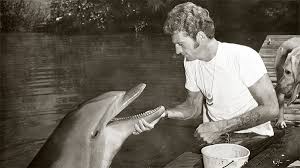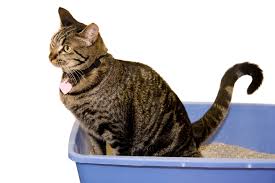Recovering Dolphin Trainer
Ric O'Barry, The Dolphin Project
 Remember America's favorite dolphin Flipper? Ric O'Barry was her trainer. When one of the 5 Flippers died in his arms, he decided that what he was doing was wrong. Now he heads a crusade to release and rehabilitate dolphins in captivity. He'll explain why he's changed his stance 180 degrees and turned down millions to do what's right for the animals.
Remember America's favorite dolphin Flipper? Ric O'Barry was her trainer. When one of the 5 Flippers died in his arms, he decided that what he was doing was wrong. Now he heads a crusade to release and rehabilitate dolphins in captivity. He'll explain why he's changed his stance 180 degrees and turned down millions to do what's right for the animals.
Ric O'Barry is a man dedicated to fixing his mistakes. He has worked on both sides of the captive dolphin issue, making him an invaluable asset in the efforts to end exploitation. He worked for 10 years within the dolphin captivity industry and has spent the past 50 working against it.
In the 1960s, Ric was employed by the Miami Seaquarium, where he captured and trained dolphins, including the five dolphins that played the role of Flipper in the popular American TV series of the same name. He also trained Hugo, the first orca kept in captivity east of the Mississippi. But when Kathy, the dolphin who played Flipper 90-percent of the time, died in his arms, Ric realized that capturing dolphins and training them to perform silly tricks is simply wrong. From that moment on, Ric knew what he must do with his life. Ric states that dolphins don't need to be trained at all. They've been around, complete and perfect, for 65 million years and they don't need him to train them to be dolphins.
The first dolphin Ric tried to free was at a Lerner Marine Laboratory. You might remember the name Lerner, it was a line of dress shops, and this laboratory was a tax write off for them in the Bahamas. Surprisingly at one time there were several dolphins there that Ric had originally helped capture, but there was only one still alive named Charlie Brown. Ric tried to free him, but was not successful and ended up in jail. Coincidentally it was on the First Earth Day in 1970. Ric has been trying to free dolphins ever sine and has come up with a better way to rehabilitate and release the back in the wild instead of just cutting the fence.
 Over the past 50 years, Ric O'Barry has rescued and rehabilitated dolphins in many countries around the world, including Haiti, Colombia, Guatemala, Nicaragua, Brazil, South Korea, the Bahamas Islands and the United States. He is a leading voice in the fight to end brutal dolphin hunts in Japan, Solomon Islands, Faroe Islands, Indonesia and wherever else they occur.
Over the past 50 years, Ric O'Barry has rescued and rehabilitated dolphins in many countries around the world, including Haiti, Colombia, Guatemala, Nicaragua, Brazil, South Korea, the Bahamas Islands and the United States. He is a leading voice in the fight to end brutal dolphin hunts in Japan, Solomon Islands, Faroe Islands, Indonesia and wherever else they occur.
Ric states that it's real obvious if you're paying attention that these animals should be free. He says he was paying attention, unlike the other dolphin trainers, and he didn't go home at 5:00 when the place closed, he actually lived there. He was there for seven years and got to know them very well, and when you know them you know they don't belong in captivity.
He says training dolphins was a failed experiment and it all came down to money, under the guise of education, research, science and al that nonsense, but it's really about money and only money.
It wasn't that way when he started, but Ric he did become aware of it later and he could have stayed in the industry. At that time, Sea World hadn't been formed yet, but Ric felt he could have gone one and probably even been the head trainer or maybe even the Vice President of Sea World. May he could have even started his own dolphin show in the Bahamas, where he could be making $10 million dollars a year, but he wouldn't be able to sleep at night.
 Ric explains that he got into the business at a young age. He was only 20 years old and had just gotten out of the military where you are brainwashed into not questioning authority and are trained to take orders. In just a few years he was making very good money working with the dolphins and was driving a new Porsche every year. Good thing he is not the same guy today!
Ric explains that he got into the business at a young age. He was only 20 years old and had just gotten out of the military where you are brainwashed into not questioning authority and are trained to take orders. In just a few years he was making very good money working with the dolphins and was driving a new Porsche every year. Good thing he is not the same guy today!
When people state that most children would not even be able to see these animals up close if it weren't for these facilities, Ric debates that. He states that these same children will never see a snow leopard - so does that mean we have to go to the Himalayas and capture one for them to see? He states you can't always get what you want and children don't have to see dolphins performing in a building, which is actually a form of bad education.
http://www.dolphinproject.net
Cooking For Your Pet
Marc Ching, The PetStaurant
 Marc Ching of ThePetStaurant.com believes the only real healthy way to feed your pets is to cook human-grade foods for them. He'll tell us some of the ingredients that we should and shouldn't use. Listen up if your pet needs to lose a few pounds.
Marc Ching of ThePetStaurant.com believes the only real healthy way to feed your pets is to cook human-grade foods for them. He'll tell us some of the ingredients that we should and shouldn't use. Listen up if your pet needs to lose a few pounds.
To help your dog or cat live a healthy and long life, cooking or preparing your own food may be your best and most preferred option. Why? Because in preparing our own meals we have control over the ingredients we use and the quality of the food. And as we get better at preparing our pets meals, we can fine tune elements catering to the pickiest of animals and those that have health problems.
What complicates things and puts animals at risk is when we do not correctly know how to prepare fully complete and healthy meals. People think that chicken and rice is healthy, but dogs and cats do not have the enzymes to break down and process certain things.
Because of this, we may actually be hurting our pets instead of helping, even if we have the best of intentions.
That is why it is very important to know how to correctly prepare meals and feed, so that all nutritional requirements are met. Some breeds do better with certain ingredients and some dogs that lick their feet should not eat Sweet Potatoes or Pumpkin. With cats, it's even more difficult to make sure they get the correct amount of Taurine.
That's where The Pet Restaurant comes in. They teach people how to cook and say it easier than you think. Do you have a dog with constant diarrhea? A cat that has crystals or stones? Did your vet tell you your pet has to be on a prescription diet in order to get better? If so, they can both advise and help you feed and care for your animals.
They want you to start with a protein source, the leaner the better. Then select from one to three green vegetables. Try to stay away from things like carrots that have sugars and high starch. And if you use a blend of vegetables, you are more likely to hit many different vitamin categories that you wouldn't get if you used, for example, just spinach and chicken.
Some meats they recommend are:
Turkey Breast (lean ground is okay too)
Chicken Breast (if you are concerned about a chicken allergy then do not use)
Beef chuck roast or other similar cuts of meat (if using ground beef we suggest using 85/15 or better)
Whitefish - this is the best and most nonreactive meat source you can use. However, some dogs hate fish.
Bison / Pheasant / Venison - hard to find, but excellent choices as well
 Some vegetables they recommend are:
Some vegetables they recommend are:
Kale, Zucchini, Broccoli Flowerets, Green Beans, Lettuces, Bok Choy, Alfalfa Sprouts, Dandelion Greens, Spinach, Celery, BUT NO PEAS - this is a protein and high in calories
How to Cook:
Cut meat and cook in a stockpot. They recommend an anodized stockpot. Do not add any water, oil or salt when cooking.
Your Veggie mix can either be cooked with the meat or blended / emulsified and added raw.
If you cook your veggies, they suggest adding a multi vitamin that is filler free.
If you blend / emulsify them and add them raw, then the prepared meal will be that much more vitamin rich.
Meat should be minimum 60% of the diet. The veggies mix the other 40.
This meat to veggie ratio is more ideal for adequate health. 60/40 means - 6 pounds meat / 4 pounds green veggies. Use a combination of at least 3 veggies.
You can cook and package food in portions, freezing them so you do not have to cook every day.
If you still have concerns about your pet getting the proper nutrients when home cooking, you can add multi-vitamins to the pet food. There are so many on the market and Marc actually recommend human supplements. This is because there is more regulation on human supplements than there are on pet supplements. One he recommends is Symmetry by Whole Leaf Organics. For omegas, he recommends coconut oil, which is inexpensive. If your dog has an itching problem, he recommends probiotics and enzymes.
Dr. Debbie warns us about some studies that recently showed home cooked recipes that were recommended and published by a majority of veterinarians, where 62-percent of them were vitamin deficient; 86-percent were deficient in minerals; 55-percent were low in protein; and Taurine, which is incredibly important for cats, was low in 77-percent of them. She believes home cooking has its place and can definitely be a benefit, but she doesn't advise someone to just pick four ingredients, throw them together with a multi-vitamin and think it's good.
Always check with your veterinarian before home cooking to make sure your pet is receiving a healthy and balanced diet.
http://www.thepetstaurant.com
Consumer Reactions to Cloning
Melain Rodriguez, ViaGen Pets
 ViaGen Pets has been operating for over 5 years now. Over that time, Melain has spoken face-to-face with hundreds of pet owners. She tells us that the responses that she gets from these people are amazing!
ViaGen Pets has been operating for over 5 years now. Over that time, Melain has spoken face-to-face with hundreds of pet owners. She tells us that the responses that she gets from these people are amazing!
Melain explains that she was at a pet expo and had the opportunity to speak with many pet parents about ViaGen Pets and their genetic preservation and cloning services. She explains the look on people's faces was pure amazement when they heard what they do and that their reactions are that this is too good to be true! She loves to inform pet parents about their services, because it is something that they are all interested in. The majority of the pet parents that she speaks with have no idea that this technology is available for their pets.
Genetic preservation and cloning are two different things states Melain. The first step to cloning is called genetic preservation. This is just preserving cells now from your pet, which can be stored indefinitely and can be used for cloning at any time down the road. You may not clone your dog or cat today, but you can preserve the cells now and save them for sometime in the future when you're ready to clone.
The most common thing that Melain hears when she is telling people about their services who have never heard about them before, is that people say they wish they had heard about this sooner, because they had the best pet ever that recently passed away.
Unfortunately you can't do cloning from ashes or from the fur of an animal. To clone you need living cells that are cultured from living tissue samples. This is done by a tissue biopsy completed by your veterinarian.
Some pet lovers have concerns about the animals that carry the clones. Are these surrogates treated humanely? Melain explains that they are a company of animal lovers, and that every animal that is involved with process every step of the way, is very special and treated with the utmost care.
How To Achieve Litter Box Success - Dr. Debbie
 It's important to realize not all cases of inappropriate elimination are a "behavior" problem. In confirmed behavioral driven house soiling cases, 20-percent of the cats also had a contributing medical condition at the time. So even if it sounds like a behavioral problem, see your veterinarian to ensure your cat isn't the 1 in 5 that has discomfort, infection, or other health problems influencing her litter box use.
It's important to realize not all cases of inappropriate elimination are a "behavior" problem. In confirmed behavioral driven house soiling cases, 20-percent of the cats also had a contributing medical condition at the time. So even if it sounds like a behavioral problem, see your veterinarian to ensure your cat isn't the 1 in 5 that has discomfort, infection, or other health problems influencing her litter box use.
Drawing Kitty To The "Right" Spot
Check the condition of the box - is it urine stained on the bottom? Throw it out and get a new one. Keep the box clean by scooping twice daily and by performing a complete litter change out twice a week for non-clumping litter or every 2-3 weeks for clumping varieties.
To entice kitty back to the litter box try a litter box attractant like the herbal-based cat litter additive called "Cat Attract."
Multi-cat homes or those with outdoor cats nearby should use pheromone (scent hormone) products to ease social stress and facilitate litter box harmony.
Kitty Eliminates Near, But Not Quite In The Litter Box
Your kitty is telling you that she understands what you want her to do, but something isn't quite right in the litter box environment. First start with providing a larger box, even if this means buying a plastic under bed storage box for this purpose. Look for one sized 18 x 36 inches in size.
Remove any litter box covers. Revisit the traffic flow in the litter box area. Ensure the box is in a quiet, low traffic area. Keep the box unquestionably clean.
Is Your Cat Urinating In Tubs Or Sinks?
Chances are your cat has urinary tract inflammation or infection. The cool surfaces provide relief to the inflammation or discomfort of a medical condition. See your veterinarian for a urine evaluation and treatment since environmental changes alone will not stop the behavior.
To preventing further episodes, decrease access to tubs and sinks, close doors to bathrooms, or fill the bottom of sinks and tubs with a small amount of water.
 Kitty Eliminates On Throw Rugs And Won't Use Litter Box
Kitty Eliminates On Throw Rugs And Won't Use Litter Box
Your cat has already made a litter preference. Perhaps the texture of carpet is more appealing than the litter used. Provide a litter box smorgasbord. This is when you provide multiple litter pans at the same time, each with different litter varieties such as clay, clumping, and natural pine litter. Be sure to include one litter box with sections of throw rugs or carpet remnants lining the bottom. During this time, remove all throw rugs from the house or block kitty's access to those areas.
If kitty demonstrates a litter preference, switch her litter boxes to that style of litter.
If kitty chooses the rug-lined box, then continue providing carpet lined litter boxes to establish a good pattern of repeated box use. Gradually start sprinkling small amounts of cat litter in the box on top of carpet surface. With time, many cats can be retrained to accept the box as the carpet is phased out and just litter remains.
Prevent Returning To Scene Of Crime
Clean all house soiling accident sites with an enzyme based pet cleanser. The enzymes break down the chemical component of the odors, and do more than just cover up with scents. Do not use ammonia based cleansers on accident areas - doing so is counterproductive. (Remember that urine contains ammonia products.)
Cats dislike eating in areas that they eliminate, so place food and water bowls in the site of the accidents, or try placing pieces of aluminum foil in areas to deter kitty's use.
Citrus scents are offensive to cats and can be an effective cat deterrent. Use citrus or potpourri scented air fresheners in the area. If your cat is eliminating in house plants, place lemon or orange peels in the pot to make the area less attractive. And of course, make sure you aren't using citrus scented cleaners on the litter pan!
To keep your kitty away from areas she continues to eliminate on, use double sided sticky tape or turn plastic carpet runners upside down. Another option is to invest in motion-activated devices that spritz out citronella or puffs of air when the electronic eye picks up motion in the off-limits area.
The Tough Reality
For some cats, environmental changes aren't enough and drug therapy may be a necessary tool. But remember that behavioral medications aren't a shortcut - drug therapy must be used with veterinary monitoring and in conjunction with environmental changes.
Want to hear some bad news? In households struggling with many years of feline house soiling, it may be necessary to discard urine marked furniture, change out carpet, carpet pads, and treat sub-flooring to effectively remove scent triggers for future elimination issues. It may sound extreme, but it can be important step to achieve faithful feline litter box success.
Featured veterinarian known as "Dr. Debbie" on national pet radio program, Animal Radio. Ebook author of "Yorkshire Terriers: How to Be Your Dog's Best Friend"; "Pugs: How to Be Your Dog's Best Friend"; "Mini Schnauzers: How to Be Your Dog's Best Friend"; and "Shih Tzu: How to Be Your Dog's Best Friend." Dr. Debbie's books.
Visit Website
Back to School Pet Blues Checklist
Robert Semrow, Animal Radio Listomania
 I, like so many parents of two legged children are at that point of the year where we've enjoyed spending time with the kids, taking some trips, doing fun activities and now I am ready, even if they aren't, for the kids to go back to school. I do enjoy my time with them and wish summer could go on forever. OK - maybe not. But while I'm relishing this glorious transition, I know that my pets are not. So, on this week's list I thought I'd share some ways to prepare for the Back To School Pet Blues.
I, like so many parents of two legged children are at that point of the year where we've enjoyed spending time with the kids, taking some trips, doing fun activities and now I am ready, even if they aren't, for the kids to go back to school. I do enjoy my time with them and wish summer could go on forever. OK - maybe not. But while I'm relishing this glorious transition, I know that my pets are not. So, on this week's list I thought I'd share some ways to prepare for the Back To School Pet Blues.
First, keep in mind that your pets, dog, cat, bird or even desert tortoises, have all enjoyed the extra time and attention that they have received because there is no after school homework, strict bedtimes and that general feeling of being free. Remember that our pets don't understand the subtlety of school being in session or out of session. They only know that they are getting the attention that they deserve. So, as you transition in to less time and more responsibilities, remember that your responsibility to your pets is to be aware of their needs and to accommodate them as much as possible during transitional times.
Next, the time urgency means different routines in the morning. It can also mean more stress. Our pets feed off our energy levels and can manifest our stress in their bad behaviors. Remember those shoes or that beautiful chair that served as their stress relief. If you want to avoid that, change or modify some of the habits you have that you see raising their stress level. It could be not getting ready with them in the room or it might be having them in a separate area of the house when getting ready to leave. That familiarity of this is where I'm supposed to be when my human parents are leaving can be calming.
 Also, communicate with your pets. No, don't turn every goodbye into a two-hour French movie drama, but acknowledge them and let them you know you'll be back. I tell my pets I love them and I'll be back soon whenever I'm leaving. For them it is calming and reassuring. I also make sure they are not following me to the door. That avoids two issues - one, the possibility of quick escape or attempt to go with me and also the anxiety of the door closing them in.
Also, communicate with your pets. No, don't turn every goodbye into a two-hour French movie drama, but acknowledge them and let them you know you'll be back. I tell my pets I love them and I'll be back soon whenever I'm leaving. For them it is calming and reassuring. I also make sure they are not following me to the door. That avoids two issues - one, the possibility of quick escape or attempt to go with me and also the anxiety of the door closing them in.
Another thing that works for many is to leave a TV or Radio on so that they hear chatter and voices and don't have that scary movie left home alone feeling all day. Many TV's have timers so that's easy to set and give them on and off time.
Additionally, consider leaving a T-shirt with your scent in their bed or near their resting area. Many times the smell of their loved ones provides the comfort they need to relax.
In the end, it all comes down to the most important thing any pet parent must do - know your pet. Know what calms them and what stresses them out. Know what steps you can do to help them. If you're not having the success you need, look to a professional for some advice.
Share your Back To School Pet Blues solutions on our Animal Radio Facebook Page.
http://petworldinsider.com
Animal Radio News - Lori Brooks
 Sperm Quality Decline in Dogs Might Explain Same Problem in Humans>
Sperm Quality Decline in Dogs Might Explain Same Problem in Humans>
Sperm quality in dogs has fallen rapidly over the past three decades, a trend which could help explain the decline in human fertility. The finding was highlighted in a study by the University of Nottingham that found a potential link between environmental contaminants and fertility, after they discovered chemicals in commercial dog food that seem to have a bad effect on sperm function. The research team collected semen from as many as 97 stud dogs every year over 26 years. Sperm motility declined by 2 and 1/2 percent per year between 1988 and 1998, which then decreased to a rate of 1.2 percent each year from 2002 to 2014.The researchers also found that male pups fathered by the stud dogs with declining semen quality were more prone to cryptorchidism, where only one of the testes descends into the scrotum. Some experts say the study "begs the question" whether a similar effect could be observed in human male fertility. Researchers at the University of Nottingham believe that the study could help explain the reported significant decline in human semen quality.
 Pets Make Healthier Work Places
Pets Make Healthier Work Places
According to the Society of Human Resource Management, 7-percent of employers allow pets to come to work with their owners. That is up 2-percent in the last five years. Okay, it's not an overnight change, BUT it is a change in the right direction for pet parents and for healthier workplaces where pets are known to drastically change things for the better for their humans. At North Carolina based Replacements, the company makes and sells fine dining ware. That could be your typical bull in a china shop scenario, but not there. Of the 400 employees who work at Replacements, about 30 of them bring pets to work every day and they have never, ever had a case of a pet breaking anything. Humans yes. Pets no. A study at Virginia Commonwealth University in 2012 measured levels of cortisol in workers' systems and found that people whose pets came to work saw a decrease in stress throughout the workday, whereas those who didn't have a pet saw their hormones increase. It's a win/win. That's not to say problems don't sometimes arise. In the case of Buchanan Public Relations outside Philadelphia, a toy poodle named Romeo who had a Napoleon complex terrorized Lacey, a Rottweiler mix. But Instead of reneging on the pets-at-work policy, the owner of the company hired a dog trainer to sort things out. Romeo gave up some of his treasured territory and workplace harmony was restored.
 People Flock to Museum - For the Cats!
People Flock to Museum - For the Cats!
For decades, the Forest of Stone Museum in central China has been a popular tourist destination for people who wanted to see its collection of ancient stone monuments. But now, the courtyard at the museum has become the main attraction as visitors began posting pictures of themselves with a family of stray cats that had taken up residence. The museum was planning on catching and giving the cats away after complaints that one of the cats had scratched a small child who was trying to play with her kitten. Once Internet users got wind of the plan, the museum's page was flooded with thousands of angry comments. Some people threatened to boycott the museum if the cats were not allowed to stay, while others pointed out that the cats were one of the reasons that they were looking forward to a future visit. As one poster noted, "Cats don't attack people unless provoked, it's humans that need to keep themselves in check." Luckily for the cats and their legions of fans, the museum had a change of heart. After seeing the outrage sparked online, they have announced that the cats will be allowed to stay, saying they will now be neutered, given vaccinations and flea and tick control. We like what the founder of the Beijing-based Good Dog Good Cat Companion Center says, "I always believed that how people treat animals reflects how civilized a society is."
 $10,000 Reward For Missing Dog
$10,000 Reward For Missing Dog
The owner of a French Bulldog that went missing in Northern California offered a huge reward for information leading to the safe return of her 6-year-old named Sassy Pants. The dog disappeared in Novato, that's in Marin County, several years ago when she broke away from her dog sitter to go chase after a squirrel. Sassy Pants' owner even hired a pet detective and two animal communicators, both of whom told her they believe Sassy Pants was still alive. This frustrated and heartbroken pet parent even offered a $10,000 reward for the safe return of the dog. Unfortunately she can't rule out foul play because three times the owner returned to the area where Sassy Pants disappeared and put up dozens of lost-dog fliers, only to have all of them torn down, which raised suspicions. Why would someone do that? Sassy's mom says, "It almost seems like someone is keeping her and doesn't want the attention." But, she also says she is not giving up. And, like many of us, she adds, "I don't have a kid. Sassy Pants is my kid."
Just How Far Would You Go For Your Pet?
The battle between the pets rages on, but both sides can agree that having a dog or cat means more than just having something to cuddle, since more and more Americans view their furry children as part of the family. So, just how far would pet owners go to protect their dogs and cats? Abodo.com surveyed 2,000 people to find out who took their role as pet parents seriously and who just wanted an animal around for companionship. Would they leave their significant other over a pet? Would they rescue them first in a house fire? Would they go hungry so their furry friend could eat? They found that nearly 9 out of 10 people said that they would save their pet from a fire before saving a family heirloom. Other results of the survey showed:
- 58-percent said they would pick having their pet over their dream home
- 63-percent would choose their pet over their significant other
- more than half would rather resort to cannibalism before eating their own pet
- 25-percent would lose a limb for their dog or cat
- 54-percent would lose a finger so a pet could keep a leg
- 69-percent would keep their pet even if they were offered a blank check for it
Dog owners are most likely to keep their fur baby and live in a shack, rather than give up the pet for their dream hoe. They would also give up the Internet forever to keep their pet or jump into boiling water to save their dog. More cat owners were most likely to: choose their cat over their significant other and were most likely to have their fur child designated World's Most Ugly Cat in exchange for a million dollars.
 Listen to the entire Podcast of this show (#1135)
Listen to the entire Podcast of this show (#1135)





